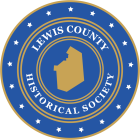The Lanphere Collection – Musical Instruments of Biblical Times

The Lanphere collection represents one man’s passion – that of noted biblical instrument archeologist and professor of music, Lewis County’s own Charles Nathan Lanphere.
This exhibit, on display at the Lewis County Historical Society during the summer of 2023, included musical instruments made by Charles N. Lanphere around 1900 to illustrate two of his widely-acclaimed lectures and concerts – “The First Ten Thousand Years of Music” and “Music of the Bible.”

Born June 15, 1869 in the town of Harrisburg just outside Copenhagen, Prof. Lanphere’s formative years were spent on the family farm on the Alexander Rd., within a stone’s throw of Deer River. He came from a devout Methodist New England family. By the age of four, he had heard many of the beautiful stories of the Bible from his mother and he could recite them from memory. Along with
his early interest in the Bible, he also developed a keen interest in music, building his first violin at age 10 (against the wishes of his father initially, who feared he would use it to play dance tunes). Strongly devote, however, the young Lanphere quickly turned his interests to the ancient music of biblical times.
Schooled initially at a small common school on the Wood Battle Rd. outside of Copenhagen, he was soon accepted for study at Lowville Academy, where he would hone his interest in music and ultimately graduate. He then took secondary music courses at the Potsdam Normal School (where he met his future wife, Harriet Ellis, a Potsdam native). But quite quickly he returned to Lowville, where he was awarded his first professorship, serving as Professor of Music at Lowville Academy – and to earn a little extra money, he taught music lessons on the side.
Known throughout his life as a dapper dresser, with a pronounced handlebar mustache, Prof. Lanphere could be seen on the streets of Lowville wearing a long black cape and silk top hat – often stopping to spread his cape, tip his hat and curtsey in the European style when meeting someone along his way. He
and his wife, who also taught music in Lowville, would stay in the village until the mid-1890s, when they chose to leave the area so Prof. Lanphere could pursue and obtain additional music degrees from the New England Conservatory of Music and the Virgil Piano School of Chicago.
Fascinated by the development of music from its very beginnings, Prof. Lanphere would later travel to Europe and study in London, Paris and Dresden. During that time, he wrote and delivered two widely acclaimed lectures, “The First Ten Thousand Years of Music” and “Music of the Bible.” The instruments in this exhibit were made by Prof. Lanphere around 1900 to illustrate these lectures.

Among his instruments, the exhibit contained: the actual violin he made at age 10; a Nabel (an Assyrian harp of ten strings); a Psaltery (a Middle Ages forerunner of the modern piano); a Toph (an Egypto-Israeli hand drum); a Crotalum (an Egyptian percussion clapper); a Tambourine (from the Egyptian-Hebraic period); a Nebel (a Harp of the Hebrews); a Lefre (an Egyptian Horsehead Lyre); a Psanterin (from the book of David); a Nofre (Egyptian Lute); a Kinnor (the first stringed instrument mentioned in the Old Testament); and a Sebaca (a Harp described in the Bible).
After years of world travel, Prof. Lanphere returned to the North Country, settling in his wife’s hometown of Potsdam, where he began teaching piano at the Crane department of music at the Potsdam Normal School (later to become Potsdam Teachers College and eventually the State University of New York at Potsdam). By all accounts, he was beloved locally as a teacher and a person. He died in 1940, and he and his wife are buried in Potsdam’s Bayside Cemetery.
The instruments in this collection were donated to the Potsdam Public Museum, which generously made some of them available to the Lewis County Historical Society for this exhibit. Special thanks are due the Potsdam Public Museum, Mimi VanDeusen and Mary Gilbert for having made this exhibit possible.
Explore More Posts
Categories
- Goings On (5)
- Objects & Artifacts (2)
- People (9)
- Places (5)
- Preservation (2)
- Uncategorized (15)
